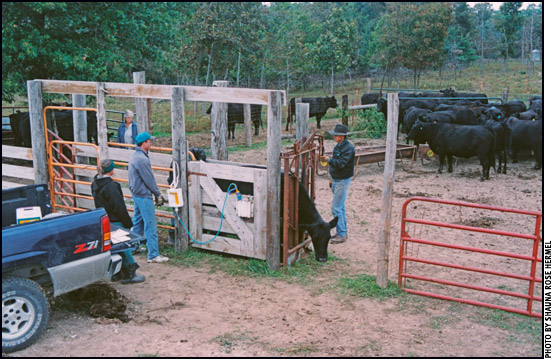
Cow Temperament Affects Reproduction
Culling on temperament or adapting cattle to handling could help in maximizing reproductive performance in beef cows.
Sometimes we wonder if that cow rattling the chute is worth keeping. Recent research suggests maybe not, said Elaine Grings, South Dakota State University (SDSU) Extension cow-calf management and production specialist.
Grings points to studies conducted several years ago with Brahman-cross cattle revealing cows with excitable temperaments had lower pregnancy rates than their calmer herdmates. Oregon State University researchers Reinaldo Cooke, D.W. Bohnert, B.I Cappellozza, C.J. Mueller and T. DelCurto expanded the study to look at the effect of cattle temperament and acclimation to handling on reproductive performance in Angus ✕ Hereford-cross cows. Their results were reported in the October issue of the Journal of Animal Science (2012.90:3547-3555).
More than 400 spring-calving range cows at two locations in eastern Oregon were tested for temperament using both a chute score and measurement of exit velocity from a squeeze chute. The chute score is based on a 5-point scale, with 1 being assigned to calm cattle that exhibited no movement and 5 being assigned to violent animals that exhibited continuous struggling.
Exit velocity was measured with an infrared sensor and converted to a 5-point scale, with 1 being assigned to the slowest exits and 5 being assigned to the quickest exits. The chute and exit scores were averaged to give a temperament score. Animals with a score of less than 3 received a score of “adequate.” Animals receiving a 3 or greater received a temperament score of “aggressive.” About 25% of the cows were scored as aggressive, and those cows had a lower pregnancy rate of 89% compared to the adequate temperament cows, which had a pregnancy rate of 95%.
“At one location, cows were bred by AI (artificial insemination) and then exposed to natural-service clean-up bulls. The second location used natural-service mating only,” Grings said. “The fact that bulls were used indicates that the lowered pregnancy rates in the aggressive cows were not due only to stress during handling at AI.”
Cow body condition and calf birth and weaning weights were not different between the groups, and there were no differences between groups in pregnancy loss or loss of calves from birth to weaning. Decreased weight of calves weaned per cow exposed in the aggressive groups was related to the effect on pregnancy rate alone.
“Based on this and other studies, the researchers suggest culling on temperament or adapting cattle to handling could help in maximizing reproductive performance in beef cows,” she said.
These researchers reported on a second study on the effect of acclimating heifers to handling on reproductive performance. After weaning, they divided 6-month-old heifers into two groups of about 44 heifers each. One group was processed through a handling facility three times a week for four weeks. Heifers receiving more frequent handling reached puberty at an earlier age than their herdmates, but pregnancy rates after AI were not different. The more frequently handled heifers had lower exit scores, but not chute scores compared to those handled less frequently.
“The researchers therefore suggest that exposing heifers to handling and human interaction may improve reproduction,” Grings said. “They do caution that this training needs to occur when animals are fairly young.”
In a previous study, when they attempted to acclimate mature cows to handling, they were not successful at improving pregnancy rates. Grings says there are still some questions left to be answered.
“We still need to determine what the minimum amount of handling needed to train an animal [is] and what is the best age for training,” she said.
In summary, pregnancy rates were improved in groups of cows with less aggressive temperaments. Heifers acclimated to handling at about 6 months of age reached puberty at an earlier age and had lower chute exit scores than heifers handled less frequently. Acclimating young animals to handling and culling on temperament may have beneficial effects on reproduction in beef cattle.











